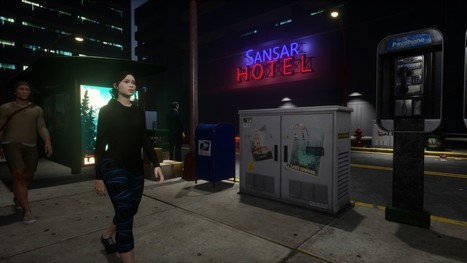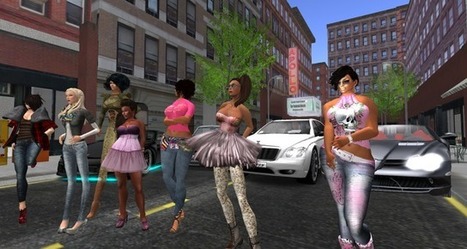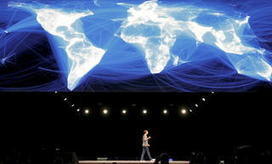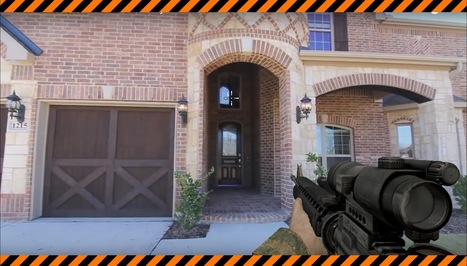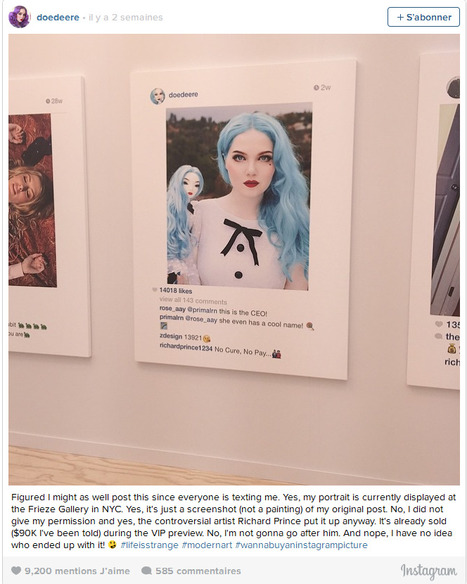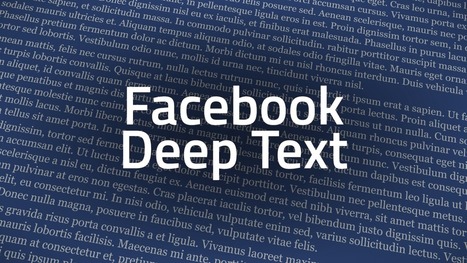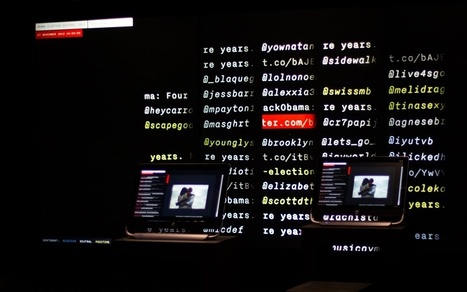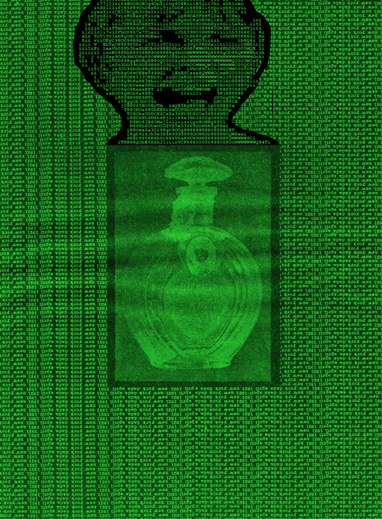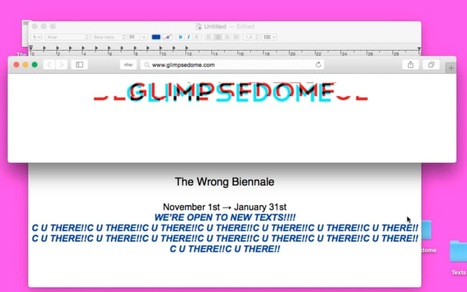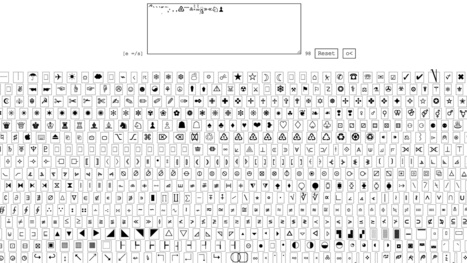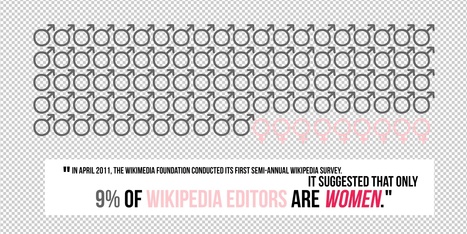 Your new post is loading...
 Your new post is loading...
Sansar is a new social, virtual-reality world coming later this year from the company behind Second Life. In theory, you can do whatever you want in virtual reality, and my VR tour guide and I are taking this seriously: we’re dressed like aliens (he’s red; I’m green), standing on the stern of a floating ship looking out at beautiful tiny islands levitating in the distance and a serene garden below us. Where else can we go? The possibilities are limitless, in a sense, because we could also just build a new virtual space to hang out in if what we want doesn’t exist...
A few months ago, jaws dropped as Facebook shelled out $2 billion to purchase Oculus VR, a virtual-reality headset company started on Kickstarter. Nobody knew why the social network had acquired this cyberpunk technology company. That was, until last night at the Techcrunch Disrupt conference, where Oculus CEO Brendan Iribe revealed what many of us thought might be too sci-fi to simply assume: Facebook would like to build the first billion-person game...
Deep neural networks are remaking the Internet. Able to learn very human tasks by analyzing vast amounts of digital data, these artificially intelligent systems are injecting online services with a power that just wasn’t viable in years past. They’re identifying faces in photos and recognizing commands spoken into smartphones and translating conversations from one language to another. They’re even helping Google choose its search results. All this we know. But what’s less discussed is how the giants of the Internet go about building these rather remarkable engines of AI.
Le réseau social utilise l’intelligence artificielle pour générer des cartes de très haute résolution. Le système mis au point vise à cartographier la planète entière en quelques semaines, et à y repérer chaque habitation. Facebook travaille sur un projet qui va donner un sacré coup de vieux à Google Maps et ses “simples” photos satellite. Dans un communiqué diffusé le 22 février et intitulé “Connecter le monde avec de meilleures cartes”, le réseau social a annoncé qu’il était en train de mettre au point un système d’intelligence artificielle capable, à terme, de cartographier le monde entier et d’analyser la répartition des lieux d’habitation. ...
onedotzero created a bespoke installation for Twitter at Cannes Lions Festival 2015.
Twitter commissioned onedotzero to create a table that visualizes key Twitter campaigns from the past year. Debuting at the Tweet Suite at Cannes Lions 2015, the work weighs in at a hefty 500kg and features 204 electromagnets, 3000 ball bearings, and 25 layers of CNC cut timber, pulled together by a team of 20 craftsmen over six weeks. In true onedotzero style, the project was a collaborative effort, combining talent from the Interactive Architecture Lab of the Bartlett, UCL, with the strategic thinking and data science of the team at Twitter. The Twitter Data Visualisation table combines a mix of skills, tools and processes including robotics, engineering, electromagnetism, CNC, carpentry, code and data visualisation.
For more information visit: onedotzero.com/projects/twitter
Cuckoo is a communication device that uses public social networks as a means of private communication. Cuckoo encrypts messages into randomly generated words, meanings and noise in order to scatter them over multiple communication networks simultaneously. Each letter of an original message gets translated into complex forms of certain length forming new sentences. Those sentences get posted to aforementioned social networks, next to randomly generated noise-sentences for distraction. Read more →
http://jochenmariaweber.de
An overlay for YouTube that mimics the view associated with First Person Shooter games, turning otherwise pedestrian and innocent scenes into dangerous situations. Viewers are given the ability to pick from a series of “levels.”
Tumblr has figured out a way to make us all stare at GIFs for even longer. It's created a new area of its site called Tumblr TV, which displays endless streams of GIFs that you tune out to. The site shows nearly full-screen GIFs, which loops a few times before moving on. You can set it up to play GIFs based on a hashtag or a specific blog, but the best thing to do is search for something trippy, sit back, and enjoy.
Une polémique enfle au sujet du travail de Richard Prince exposant pour des centaines de milliers de dollars des photographies capturés sur Instagram. Elle se cristallise notamment autour de la question juridique puisque l’artiste plaide le « fair use » (usage loyal à caractère transformatif) pour justifier la valeur artistique de son geste d’appropriation mais qui est ressenti par certains auteurs des photographies capturées comme de la simple prédation.
Dans ce blog consacré à décrire empiriquement la culture mobile sur la base de collecte de corpus et d’entretiens, nous voudrions aborder la controverse Richard Prince en nous focalisant sur le type de contenu au coeur de cette polémique, à savoir non pas des photographies mobiles mais des captures d’écran agrandies et exposées.
En effet, ce contenu « capture d’écran » devient, selon nous, crucial à l’heure où nos existences connectées peuvent s’apparenter à un ready made by mobile. A travers la « capture » de soi, des autres, du monde dans le flux de nos conversations digitales créatives mixant sur le vif des images et des mots tout au long d »une journée, la banalité de nos vies quotidienne se trouve théâtralisée, mise en scène, racontée… bref se trouve transfigurée tel un objet trivial promu oeuvre d’art comme « ready made » par l’artiste Marcel Duchamp. ...
Quand j'étais bien plus jeune, je me souviens de mon ahurissement en apprenant que l'émission "Le vrai journal" de Karl Zéro, diffusée à l'époque en clair sur Canal+ allait se voir l'obligation de faire figurer en sous-titre apparent de tous ses détournements et fausses interviews la mention "réalisé avec trucage". Mon étonnement venait du fait qu'il s'agissait clairement d'une émission parodique, qu'elle affichait clairement son objectif de détournement, et que lesdits détournement, même s'ils étaient très habilement réalisés au vu des moyens techniques de l'époque, restaient en tout cas de mon point de vue parfaitement identifiables en tant que tel. Je n'ai jamais compris si cette mention était là pour quelques esprits trop simples ou trop peu éduqués, ou s'il s'agissait d'un effet d'emballage destiné à s'éviter quelques procès médiatique au nom du droit à l'image et autres droit à la parodie. Et puis vînt Nadine Morano. Et le Gorafi fût. Alors commencèrent les faux-pas dont l'un des plus célèbres ne pouvait venir que du double neuronal de Nadine M, j'ai nommé Christine B., prenant pour authentique un article parodique du Gorafi et s'en gargarisant dans les médias. ....
At the Edinburgh Festival in 2001, Hungarian pianist Andras Schiff grew so frustrated by the interruptions of cellphones and coughing that he left the stage, suggesting the audience use the break to finish making noise. A reviewer for called it, “Fantasia in C Minor with mobile phone, beeping watches and coughing and sneezing accompaniment,” which sounds like an enjoyable evening of John Cage but not, apparently, what Schiff intended.
A decade later in Presov, Slovakia, a solo viola performance by Lukas Kmit was interrupted by the ubiquitous Nokia ringtone. Kmit paused, casting a frustrated eye on the audience — toward the guilty party, presumably, who isn’t visible in this viral video of the event. But rather than stop his performance or abandon the stage, he played the ringtone back on his instrument, adding an improvisational touch and incorporating the moment into his concert in a spontaneous acknowledgement — despite the frustration and rudeness — of the human nature of live performance. ...
Unindexed is an online community that anyone can contribute to; it runs a back-end process that continuously scours Google for signs that it has been indexed, and securely erases itself once it discovers evidence of same.
It's a cute art project (as opposed to a cute engineering project, which would have just used a robots.txt file to stop Google from indexing it altogether), and apparently included some kind of artistic statement of purpose that was nuked, along with the rest of the site, when Google indexed it 22 days in. ...
n 1997, a writer and web developer named Paul Ford walked into a sushi restaurant in midtown Manhattan to meet a group of strangers. These were bloggers—a term not yet widely in use—who, along with Ford, formed a tight-knit vanguard of individuals publishing personal writing online. Ford had been building experimental personal websites since 1993, and had made a name for himself online with his lyrical missives on programming esoterica and New York dating mishaps. He’d never met the other bloggers IRL (In Real Life, a phrase that likely had even less currency then than blogger). He was excited to finally get the chance to do so. ...
|
One Monday morning last September, Britain woke to a depraved news story. The prime minister, David Cameron, had committed an “obscene act with a dead pig’s head”, according to the Daily Mail. “A distinguished Oxford contemporary claims Cameron once took part in an outrageous initiation ceremony at a Piers Gaveston event, involving a dead pig,” the paper reported. Piers Gaveston is the name of a riotous Oxford university dining society; the authors of the story claimed their source was an MP, who said he had seen photographic evidence: “His extraordinary suggestion is that the future PM inserted a private part of his anatomy into the animal.” The story, extracted from a new biography of Cameron, sparked an immediate furore. It was gross, it was a great opportunity to humiliate an elitist prime minister, and many felt it rang true for a former member of the notorious Bullingdon Club. Within minutes, #Piggate and #Hameron were trending on Twitter, and even senior politicians joined the fun: Nicola Sturgeon said the allegations had “entertained the whole country”, while Paddy Ashdown joked that Cameron was “hogging the headlines”...
Text is a prevalent form of communication on Facebook. Understanding the various ways text is used on Facebook can help us improve people's experiences with our products, whether we're surfacing more of the content that people want to see or filtering out undesirable content like spam. in french >>> http://www.futura-sciences.com/magazines/high-tech/infos/actu/d/internet-deeptext-facebook-veut-lire-comprendre-tout-ce-vous-ecrivez-63022 With this goal in mind, we built DeepText, a deep learning-based text understanding engine that can understand with near-human accuracy the textual content of several thousands posts per second, spanning more than 20 languages. DeepText leverages several deep neural network architectures, including convolutional and recurrent neural nets, and can perform word-level and character-level based learning. We use FbLearner Flow and Torch for model training. Trained models are served with a click of a button through the FBLearner Predictor platform, which provides a scalable and reliable model distribution infrastructure. Facebook engineers can easily build new DeepText models through the self-serve architecture that DeepText provides. ...
Chorus is a data-driven art installation that translates Twitter reactions to current affairs into evocative typographic choreographies. Commissioned by the British Library for its major exhibition "Propaganda: Power and Persuasion”, the artwork examines how ideas and opinions spread via social networks, and their potential to influence public opinion. With each act in the London Olympics Opening Ceremony, a burst of excitement spans the screen. From Obama’s re-election tweet “Four more years” we zoom out to reveal it as the most retweeted message in history. In the timespan from the Sandy Hook Shootings to Obama’s state of the union address, we observe the shifts of opinions among the US pro- and anti-gun lobbies. Forming the atmospheric closing piece of the exhibition, the installation provokes questions about propagandistic patterns in contemporary digital communication.
Adam Ferriss is a photographer and digital media artist based in Los Angeles, CA. In addition to his artistic practice, Adam runs the photography labs at Otis College of Art and Design. His most recent projects involve creating tri-chromatic color separation photographs and algorithmically restructuring pixel array data.
Plagiarism is necessary, progress demands it.” — Isidore Ducasse, Comte de Lautréamont 1870 Although Dada didn’t invent collage, it was the first art movement to use it to collapse together images and ideas. Dada also pioneered concepts, logics, ideas and ways of working that were later transfused in contemporary digital tools, and became commonplace in the digital environment. “We are Duchamp’s ideal children.” — Vuk Cosic 1997 Celebrating DADA 100, and thanks to the open mindness of a private collector, the Link Art Center is sharing for over a year high quality digital copies of original Dada artworks and magazines, and inviting artists from all over the world to use them in their work. Browse them, download them, remix them, make copies and variations, integrate them in your video, animation, painterly, sculptural, interactive, whatever work, and then share it in our gallery. Dada is nothing, enjoy Dada!
Curated by: Amy Jones and Lesley Taker
In a world where we use Instagram “likes” and YouTube views to assess who and what is important, and fame is just a click away, what impact is the Internet really having on how we think about ourselves and those around us?
Follow investigates how we understand image and identity as ever-changing concepts which can be bought, sold, mimicked, endorsed, deleted and validated through a single click—as well as exploring methods to survive, subvert and utilise social media. The exhibition raises questions about the ways in which we seek validation from social media and, ultimately, explores how we behave when everyone is watching. New commissions, research and existing work will present a wide range of experiences and views of image, self-branding, identity, sharing and micro-celebrity within the context of a life lived online.
Ever since its inception, people have used the technology of the Internet to represent themselves to the world. Sometimes this representation is a construction based on who they are outside the network, such as with a personal webpage or blog. Other times people use the built-in anonymity of the Internet to explore and engage alternative identities. This identity tourism (Nakamura, 2002) takes place within game spaces (e.g. MUDs, MMORPGs), chat rooms, or forums, as well as within those spaces already mentioned such as webpages and blogs. In each case, the underlying technology that facilitates this network society of digital representations is software. How this software is designed by its creators determines the ways that users can (and cannot) craft their online representation. . The most popular network space for personal representation is Facebook, the world’s largest online social network. The site has more than 500 million active users and has become the most visited website in the United States, beating out Google for the first time in 2010 (Cashmore, 2010). Facebook functions as a prime example of what Henry Jenkins (2006) calls “participatory culture,” a locus of media convergence where consumers of media no longer only consume it, but also act as its producers. Corporations, musicians, religious organizations, and clubs create Facebook Pages, while individuals sign up and fill out their personal profiles. The information that organizations and people choose to share on Facebook shapes their online identity. How those Pages and profiles look and the information they contain is determined by the design of the software system that supports them. How that software functions is the result of decisions made by programmers and leaders within the company behind the website.
... click to read more . Glimpsedome is a digital thought pavilion aimed at displaying written knowledge and contemporary thinking. Understanding digital culture as an on-going construction of a transdisciplinary process, we have brought together different voices coming from the fields of art, philosophy, engineering, design, social sciences, fiction, poetry, activism, critical thought and journalism, to collectively reflect on the trends and trajectories of creativity and culture in the ever-shifting internet paradigm. The pavilion will also act as real-time device to reflect on the events happening at The Wrong Biennale. Curated by the digital culture researcher Andreu Belsunces, Glimpsedome will gradually feature texts from Ben Grosser, Daphne Dragona, Ramón Sangüesa, Jara Rocha and Femke Snelting, Pau Waelder, Joana Moll, Elena Garnelo, Roxana Fabius, Quelic Berga, Verbatim Veirs, Andrés Colmenares and Lucy Rojas, among others. Nevertheless, Glimpsedome is an open adventure so new texts and ideas are welcomed. Glimpsedome will extend its activites away from the keyboard through talks, workshops and sessions at Hangar, a centre dedicated to art and research in Barcelona. This will be done through sessions organized by e-rregular, a transdisciplinary research project at the intersection between art, technology and society.
FACEBOOK. Instagram. Google. Twitter. All services we rely on — and all services we believe we don’t have to pay for. Not with cash, anyway. But ad-financed Internet platforms aren’t free, and the price they extract in terms of privacy and control is getting only costlier. A recent Pew Research Center poll shows that 93 percent of the public believes that “being in control of who can get information about them is important,” and yet the amount of information we generate online has exploded and we seldom know where it all goes. Facebook and other social networking sites that collect vast amounts of user data are financed by ads. Just this week Instagram, which is owned by Facebook, announced plans to open users’ feeds to more advertisers. The dirty secret of this business model is that Internet ads aren’t worth much. Ask Ethan Zuckerman, who in the 1990s helped found Tripod.com, one of the web’s earliest ad-financed sites with user-generated content. ...
“Share This - art on social networks” is a research project by Stedelijk Museum Amsterdam, Het Nieuwe Instituut, The Netherland Institute for Sound and Vision and Upload Cinema. Our aim is to explore ways of collecting and presenting artists, designers and image creators currently active on social media.This Tumblr is our open (yet slightly moderated) research environment and does not represent a curated selection by parties involved.
A research project by Stedelijk Museum Amsterdam, Het Nieuwe Instituut, The Netherlands Institute for Sound and Vision and Upload Cinema.
“Share This - art on social networks” is a research project by Stedelijk Museum Amsterdam, Het Nieuwe Instituut, The Netherland Institute for Sound and Vision and Upload Cinema. Our aim is to explore ways of collecting and presenting artists, designers and image creators currently active on social media. This Tumblr is our open (yet slightly moderated) research environment and does not represent a curated selection by parties involved. - See more at: http://sharethisresearch.tumblr.com/about#sthash.AxsQup4m.dpuf
The net.art movement makes art an interactive, almost tangible experience. Sounds like something else we know.
“Art,” as an uppercase institution comprised of oil paint portraits in gilded frames and cracked marble statues of muscular young men, is notoriously unwelcoming of audience participation. “No Touching” is the Met’s most important rule; guards pointedly remind visitors of this as they amble through the galleries. Snap a flash-less picture of the Van Gogh’s and the Picassos; Instagram, tweet, or tumble; move on.
Even contemporary art, so attached to the medium of immersive installation, has the audacity to demand “hands off.” Within an installation, it is easy to feel as though you are missing the point, if there even was a point to begin with. Chris Burden’s "A Tale of Two Cities," for example, replicates a battle field with a militia of static action figures and toy vehicles. A partition separates you from the stationary scene, but binoculars are provided in case you want to feel closer to the massive setup. ...
Well, this is sneaky—and for some, a little heartbreaking. Tinder users at the SXSW festival on Saturday were encountering an attractive 25-year-old woman named Ava on the dating app. A friend of ours made a match with her, and soon they were having a conversation via text message.
There are worlds within Wikipedia, but in a larger sense, Wikipedia is also a reflection of the world. Power structures and inequalities included. “Women, people of color, and members of marginalized communities have not historically always been represented in public discourse,” says Katherine Maher, Chief Communications Officer of Wikimedia, the foundation that runs Wikipedia. “Whether in the media, or in research, or in non-fiction work, because their voices have not always been heard or told.” Because Wikipedia works by citations of secondary sources, these voices also do not end up reflected thoroughly on Wikipedia – which essentially mirrors the information that is easily available in the world.
|



 Your new post is loading...
Your new post is loading...

